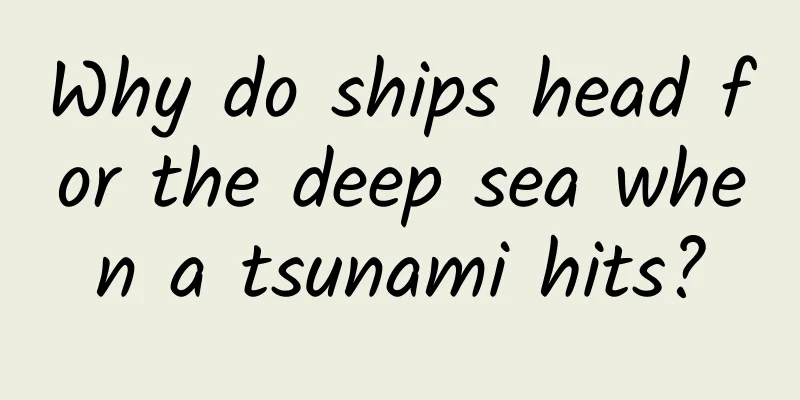Why do ships head for the deep sea when a tsunami hits?

|
Audit expert: Wang Zongchen National Marine Environmental Forecast Center (Tsunami Warning Center, Ministry of Natural Resources) Assistant Researcher It was an extremely peaceful morning when a rare 9.1 magnitude earthquake erupted in the deep sea 160 kilometers away from the island of Sumatra . Tourists on the shore discovered that a terrifyingly high wall of water suddenly rose from the sea in the distance and rushed towards them like a locomotive. This was a tsunami. This left the locals, who had not experienced a tsunami for nearly a hundred years, with the most unforgettable dark memory of the ocean. Tsunamis are super-large waves caused by undersea earthquakes, volcanic eruptions, undersea landslides or weather changes. They travel faster than airplanes in the sea, at 700 to 800 kilometers per hour, and can spread across the entire ocean in nearly 10 hours; their wavelengths are sometimes 1,500 kilometers, and they will not decay significantly even after a long period of travel. Although the wave height of tsunami seems ordinary in the deep sea, only about 0.1-5 meters, but as soon as they get close to the shallow water area near the shore, they will become extremely fierce, with the wavelength shortened and the wave height soaring, forming a "water wall" that covers the sky and the sun, and is affected by the seabed topography, coastline shape and wave characteristics, constantly impacting the coastline, and even crossing the breakwater, destroying buildings and flooding the land. In the expert lecture of Small Ball Big World "Tsunami Erupts! The Roar of the Indian Ocean", we gained an in-depth understanding of a devastating tsunami event - the 2004 Indonesian tsunami. What are the scientific principles behind this tsunami that hit the coastal countries of the Indian Ocean hard? Schematic diagram of the impact of the 2004 Indian Ocean tsunami Source: Wikipedia 1Why are tsunami disasters always so serious in Indonesia? On December 26, 2004, a magnitude 9.1 earthquake struck the seabed of the Andaman Sea north of Sumatra Island, Indonesia, triggering a huge tsunami that killed more than 220,000 people in countries surrounding the Indian Ocean, including more than 160,000 in Indonesia. On September 28, 2018, a strong earthquake and tsunami struck Central Sulawesi Province, Indonesia, killing more than 2,000 people, seriously injuring more than 2,500 others, destroying nearly 70,000 houses, and forcing tens of thousands of people to evacuate their homes. Comparison of a certain place before and after the 2004 Indian Ocean tsunami Source: Jiangsu Marine Surveillance It is not difficult to find that the two tsunami disasters in Indonesia were both caused by earthquakes, which in turn triggered tsunamis. From the perspective of plate tectonic theory, Indonesia is located at the extinction boundary of the Indo-Australian Plate and the Eurasian Plate . Due to the collision and compression of the plates, volcanic earthquakes are frequent, making it the region with the most frequent earthquake disasters in the world, with more than a thousand earthquakes of varying sizes each year. Distribution map of the six major plates and volcanic seismic belts Source: People's Education Press High School Geography Secondly, the tsunami caused particularly severe damage to coastal areas. Indonesia is the world's largest archipelago country, with more than 17,000 islands, a long coastline, and a population mostly distributed in the coastal areas of the islands. Therefore, even if there is a global tsunami warning system, it is difficult for a country like Indonesia, which is very close to the tsunami generation site, to have a response time . 2What is the difference between a tsunami and a storm surge? For coastal cities in China, people are probably less familiar with tsunamis than storms. Every summer and autumn, storm surges brought by typhoons cause varying degrees of damage to my country's southeastern coast. So, since both create huge waves when they approach the shore, what is the difference between a tsunami and a storm surge? Storm surge Source: National Disaster Reduction Network The first is the difference in origin and triggering mechanism . Tsunamis are mainly caused by undersea earthquakes, volcanic eruptions or large landslides that occur below the ocean surface. When an earthquake occurs on the seafloor, a large amount of water will be displaced vertically, generating a series of powerful waves that radiate in all directions. In contrast, normal storms (such as typhoons or cyclones) are caused by disturbances in the atmosphere, so storm surges are always accompanied by strong winds, heavy rains and thunderstorms, where the energy of the storm comes from temperature differences, humidity and atmospheric pressure. The second is that the waves differ in their formation and destructive potential . The wavelength of tsunamis is extremely long, reaching hundreds of kilometers. They travel long distances across the vast ocean and reach alarming heights when approaching the coast. Source: Internet In contrast, storm waves are relatively short-wavelength waves generated by the transfer of wind energy to the ocean surface, and their destructive power is generally limited to the immediate coast . Source: Gansu Popular Science Network In addition, storm surges and tsunamis also have obvious differences in waveform. Storm surges generally have only 1 to 2 peaks, and the wave height does not increase suddenly, but has a gradual rise process . Earthquake tsunamis have multiple peaks and several large waves arranged in succession, especially the second and third wave peaks are the highest. It is extremely rare for them to rise slowly and quietly. Most of them hit the coast loudly and violently, forming a huge wave near the shore. Source: Gansu Association for Science and Technology The third is the difference in speed and distance . Tsunamis can travel across oceans at incredible speeds, often exceeding 700 kilometers per hour (435 miles per hour), spanning entire ocean basins and potentially traveling thousands of kilometers before reaching the coastline of another continent. Storms, on the other hand, usually move at slower speeds, influenced by wind direction and atmospheric conditions, and they travel shorter distances, more likely to only affect nearby coastlines. 3What does the speed of tsunami propagation depend on? When observing the propagation time chart of the 2004 Indian Ocean tsunami, we can easily find that some lands that are closer to the epicenter in a straight line distance are eroded by the tsunami later. Why is this? Source: Small Ball, Big World The propagation time of a tsunami is actually affected by two factors. The first is the water depth. The propagation process of a tsunami in the deep sea can be roughly regarded as a shallow water wave (the wavelength is much greater than the water depth), and the propagation speed is proportional to the square root of the water depth. Therefore, the deeper the water, the faster the tsunami propagates . If the water depth of the sea area through which the tsunami propagates is relatively shallow, the propagation speed will also be slow. This will result in that although some lands appear to be closer to the tsunami source in a straight line, the tsunami will arrive slower. Source: Zhihu The second is the characteristics of the seabed. The speed and behavior of a tsunami are significantly affected by the characteristics of the seabed, including its shape and topography. A steep seabed tends to reflect incoming tsunami waves back, while conversely, when waves encounter underwater ridges or shallow waters, the speed of the waves slows down by 5 to 20 times, squeezing the wave train and causing the tsunami waves to increase in amplitude. It is the reason for the huge destructive force released when a tsunami reaches the coast, but it is also a factor that delays the arrival of a tsunami. Magnitude of tsunami propagation speed and wavelength Source: Environmental Encyclopedia As summer vacation approaches, it is a good season for seaside activities. Although the probability of a tsunami occurring along the coast of China is very small, if you feel an earthquake near the sea, you should still leave immediately. In addition, if you observe abnormal tide rise and fall, such as the sea water receding rapidly, you should leave the coast immediately because there is a high probability that a tsunami is approaching. If you want to know more about tsunamis, please pay attention to the latest lecture of Small Ball Big World! |
Recommend
Community operation: 2 steps to make a good community operation plan!
Nowadays, everyone is talking about community ope...
"People infected with COVID-19 have long-term abnormal lung function"? A secret to debunk this rumor
If you interpret the paper carefully, you will fi...
Chicken eggs, duck eggs, quail eggs, which one is more nutritious? How to choose?
Chicken eggs, duck eggs, quail eggs... There are ...
Broken bones by a leaf? Leaves in the south are really hard to deal with...
recently Mr. Liu from Jieyang, Guangdong By a fal...
How to cure "universe-level directionlessness" in one go? Scientists have come up with this method...
Who are you? Traveler... Where are you? Outside.....
Need IV drips every time you get sick? These diseases don’t require it!
For a long time, people have believed that intrav...
Does Changsha Mini Program Mall need to apply for a business license?
Can an e-commerce business license be used to ope...
Traditional car companies enter the travel field? Toyota and Didi set up a joint venture company Fengju Travel
Recently, Toyota and Didi's joint venture Fen...
Borrowing eggs to lay "chickens", China launches new charging pile technology to encourage car owners to use excess electricity to make a profit
Speaking of "reverse charging", this fu...
Drinking hot water can raise your body temperature and even help you lose weight? Don’t believe it anymore
Hello, this is Science Popularization China. Rece...
How to take advantage of hot topics to create popular advertising materials?
01. Why do selling points need to take advantage ...
Now that we have a direction, how should traditional media and emerging media be integrated?
Recently, Xi Jinping presided over the fourth mee...
Rating 9.3! Probably the best domestic documentary this year
The Chinese white dolphin, a mammal at the top of...









